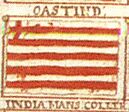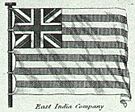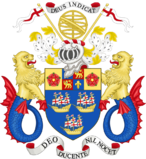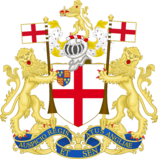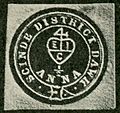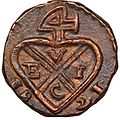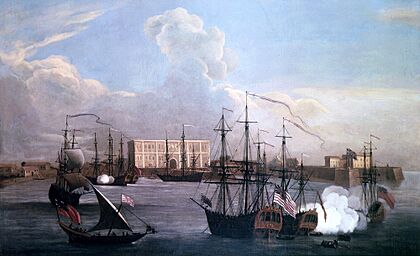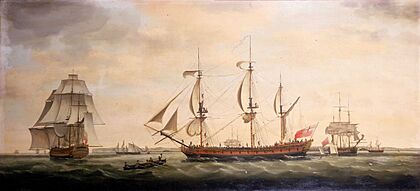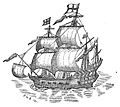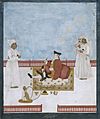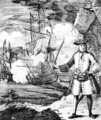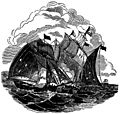East India Company facts for kids

Company flag (1801)
|
|
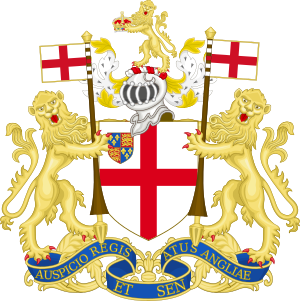
Coat of arms (1698)
Motto: Auspicio Regis et Senatus Angliae Latin for "By command of the King and Parliament of England" |
|
| Public State-owned enterprise |
|
| Industry | International trade |
| Fate | Nationalised:
|
| Founded | 31 December 1600 |
| Founders |
|
| Defunct | 1 June 1874 |
| Headquarters | East India House, , |
| Products | Cotton, silk, indigo dye, sugar, salt, spices, saltpetre, tea, slave trade |
The East India Company (EIC) was a very powerful English, and later British, company. It was started in 1600 and closed down in 1874. Its main goal was to trade in the Indian Ocean region. At first, it traded with the East Indies (which included the Indian subcontinent and Southeast Asia). Later, it expanded its trade to East Asia.
This company became incredibly large and powerful. It took control of big parts of India and also colonised areas in Southeast Asia and Hong Kong. At its strongest point, the EIC was the biggest company in the world! It even had its own army, with about 260,000 soldiers. This was twice the size of the British army at that time. The company's actions greatly changed global trade.
The EIC was first given a special permission, called a charter, to trade. It was known as the "Governor and Company of Merchants of London Trading into the East-Indies." By the mid-1700s, the company handled half of all world trade. It mainly traded in goods like cotton, silk, indigo dye, sugar, salt, spices, saltpetre, and tea. The company also began the British Empire's rule in India.
Over time, the company started to rule large areas of India. It used its military power and took over government jobs. The company's rule in India officially began in 1757 after the Battle of Plassey. It lasted until 1858. After the Indian Rebellion of 1857, the British government took direct control of India. This new rule was called the British Raj.
Even with help from the government, the company often had money problems. The East India Company finally closed down in 1874.
Contents
Forming the East India Company
In 1599, a group of important merchants and explorers met. They wanted to start a trading business in the East Indies. They hoped to get a special permission, a royal charter, from the Queen. This group included famous people like Ralph Fitch and James Lancaster. Also there was Thomas Smythe, a powerful London politician.
On September 22, they decided to invest a lot of money in this new journey. Two days later, these "Adventurers" asked the Queen for her support. Even though their first try wasn't fully successful, they kept going. They bought ships and invested even more money.
They met again on December 31, 1600, and this time they succeeded! The Queen agreed to their request. The company was given a special right to trade. For fifteen years, they had a monopoly on English trade. This meant no other English traders could trade in areas east of the Cape of Good Hope and west of the Straits of Magellan. If anyone tried to trade without the company's permission, their ships and goods could be taken away. They could also be put in prison.
The charter named Thomas Smythe as the first governor of the company.
Company Symbols
Flags of the East India Company
- Historical depictions
-
National Geographic (1917)
- Modern depictions
The East India Company's flag changed over time. It always had a small flag (called a canton) in the top left corner. This canton showed the flag of the ruling Kingdom at the time. The rest of the flag had 9 to 13 red and white stripes.
From 1600, the canton had a St George's Cross. This represented the Kingdom of England. After England and Scotland joined in 1707, the canton changed. It showed the new Union Flag. This flag combined the English St George's Cross with the Scottish St Andrew's cross. When Ireland joined Great Britain in 1800, the canton changed again. It then included a Saint Patrick's Saltire.
Some historians believe the East India Company flag might have inspired the Stars and Stripes of America. This is because the company's flag looked very similar to the Grand Union Flag used during the American Revolution.
Coat of Arms
The East India Company had its own coat of arms. This was like a special symbol or emblem for the company. The first one was given in 1600. It showed three ships with sails, and a special design at the top. It also had a crest with a globe and the words "Deus indicat" (Latin for "God Indicates"). Its supporters were two sea lions, and its motto was "Deo ducente nil nocet" (Latin for "Where God Leads, Nothing Harms").
A later coat of arms was given in 1698. This one had a red cross on a white shield. In the top corner, it showed the arms of France and England. The crest was a lion holding a crown. The supporters were two lions, each holding a banner with a red cross. The motto for this one was "Auspicio regis et senatus angliæ" (Latin for "Under the auspices of the King and the Parliament of England").
Merchant Mark
-
1 Pice (1⁄64 Rupee) copper coin of the Bombay Presidency with bale mark (1821)
When the East India Company started, merchants often had a special merchant's mark. This mark was like a trademark today. It helped people know who the goods belonged to. The East India Company's mark had a special "Sign of Four" symbol. Below it was a heart with a cross inside, and the letters "EIC" (for East India Company). This mark was used on the company's coins and on early postage stamps.
Company Ships
The ships used by the East India Company were called East Indiamen. Sometimes their names started with "HCS," which meant "Honourable Company's Service" or "Honourable Company's Ship." Examples include HCS Vestal (1809) and HCS Intrepid (1780).
During the French Revolutionary and Napoleonic Wars, the company's ships sometimes carried cannons. This was to protect them from warships, privateers (private ships allowed to attack enemy ships), and pirates. They could also get special permission, called letters of marque. This allowed them to capture enemy ships without being called pirates.
The company also had its own navy, called the Bombay Marine. These ships were warships like Grappler. They often sailed with the British Royal Navy on important missions. For example, they helped in the invasion of Java.
One famous naval victory for the company was the Battle of Pulo Aura. In this battle, a group of East Indiamen, led by Nathaniel Dance, fought off a French squadron. Six years earlier, five Indiamen tricked a French squadron into thinking they were warships, and got away safely.
East Indiamen were large and strongly built ships. Sometimes, the Royal Navy bought them to use as warships. However, because they were designed as merchant ships, they didn't perform very well as warships. The Navy often changed them into transport ships instead. Some examples of East Indiamen bought by the Royal Navy include:
- HMS Calcutta
- HMS Glatton
- HMS Hindostan (1795)
- HMS Hindostan (1804)
- HMS Malabar
- HMS Buffalo
Company Records
The official records of the East India Company are very important. Unlike most British government records, they are not kept at The National Archives. Instead, they are held by the British Library in London. They are part of the Asia, Pacific and Africa Collections. You can search for many of these records online.
There are also published lists of the company's ships' journals and logs from 1600 to 1834. These lists also cover records from schools the company ran, like the East India Company College. A magazine called The Asiatic Journal and Monthly Register for British India and its Dependencies, started in 1816, also has a lot of information about the company's work.
Early Governors
- 1600–1601: Sir Thomas Smythe (first governor)
- 1601–1602: Sir John Watts
- 1602–1603: Sir John Hart
- 1603–1606: Sir Thomas Smythe (re-elected)
- 1606–1607: Sir William Romney
- 1607–1621: Sir Thomas Smythe (re-elected)
- 1621–1624: Sir William Halliday
- 1624–1638: Sir Maurice (Morris) Abbot
- 1638–1641: Sir Christopher Clitherow
Images for kids
-
James Lancaster commanded the first East India Company voyage in 1601
-
Red Dragon fought the Portuguese at the Battle of Swally in 1612, and made several voyages to the East Indies
-
The emperor Jahangir investing a courtier with a robe of honour, watched by Sir Thomas Roe, English ambassador to the court of Jahangir at Agra from 1615 to 1618, and others
-
French illustration of Sir Josiah Child requesting a pardon from the Emperor Aurangzeb
-
The expanded East India House, London, painted by Thomas Malton, c. 1800
-
Addiscombe Seminary, photographed in c.1859, with cadets in the foreground
-
An 18th-century depiction of Henry Every, with the Fancy shown engaging its prey in the background
-
British pirates that fought during the Child's War engaging the Ganj-i-Sawai
See also
 In Spanish: Compañía Británica de las Indias Orientales para niños
In Spanish: Compañía Británica de las Indias Orientales para niños
East India Company
- Category:Honourable East India Company regiments
- Category:Medals of the Honourable East India Company
- Company rule in India
- Advocate-General of Bengal
- Chief Justice of Bengal
- Chief Justice of Madras
- Economy of India under Company rule
- Governor-General of India
- Indian independence movement
- Indian Rebellion of 1857
- Presidency armies
- List of East India Company directors
- List of trading companies
- East India Company Cemetery in Macau
General
- Anglo-Nepalese war (1814–1816)
- British Imperial Lifeline
- Carnatic Wars
- Commercial Revolution
- Lascar
- Persian Gulf Residency
- Political warfare in British colonial India
- Trade between Western Europe and the Mughal Empire in the 17th century
- Whampoa anchorage
Other


